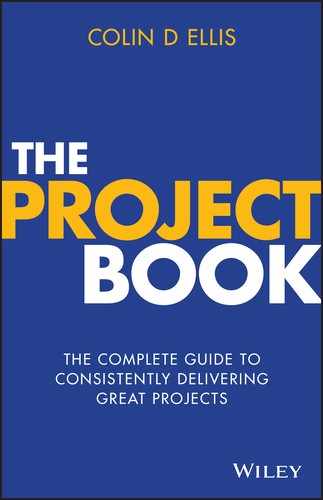CHAPTER 47
ESTIMATING
How long do you think it will take you to finish this book? I’m talking about actual reading time, eyes on the page. Four hours? Six hours? Two weeks? Some of you may choose to read just one chapter a day, in which case it’ll take you 10 weeks or so. Whatever your calculation, it is likely that your estimates will be based on your:
- history — reading books of this length typically takes you five hours of reading time over two weeks
- expertise — as an experienced book reviewer you know that books of 250 pages take 3.5 hours a day over six days.
Shortcutting the estimation process — for waterfall projects especially — is one of the most common causes of problems later on in a project. A major PwC study in 2012 listed poor estimation as its number one reason for project failure, while another survey in 2016 had ‘Improve resource planning and forecasting’ as its number one priority for project managers.
Poor estimation is a result of poor project management. Good estimation comprises collaboration, transparency, repeatability and comparability. The more information that’s available, the better the estimate will be at that point in time. It’s your job to ensure that the estimates are the best that they can be. You’ll know if you’ve done enough work because you will have complete confidence that the task will be completed on time and use the people you identified. If you don’t have that confidence, then you haven’t done enough work.
Estimates usually have four parameters:
- Role. Who will do this?
- Effort. Physically how long will it take to do it?
- Duration. Over what period of time?
- Cost. At what cost?
For the most part, you’ll use history and expertise to get to the estimate. More experienced project managers may use some flashy algorithms. In order to build the right culture for your project, however, you should always look to involve the right people in the estimation process.
History
This approach is especially useful if you have delivered comparable projects recently (within two years). The benefits of this approach are:
- You will have a good idea of the time and cost before you start the project.
- The estimate is based on running the project in your organisation, so it takes into account the way your organisation does things.
- It’s easily understood by senior managers, as evidence already exists.
For this approach to be effective the project needs to be truly comparable and recent enough to be relevant.
Expertise
In the absence of a historical precedent, you’ll need to get the right people in the room to provide you with the knowledge and experience required to build an accurate estimate. The benefits of this approach are:
- With the right people in the room, you’ll get the best possible estimate.
- It engages people in the planning process and provides a detailed view of what’s involved.
- It’s applicable to all stages of the project.
The schedule is the last part of the project plan to be completed, and the confidence that the team and stakeholders have in it is directly attributable to the estimates you’ve provided.
